Bengal beyond Bishnupur—15 heritage gems you must visit.

The temple's façade
In medieval Bengal, during Alauddin Husain Shah’s regime (1494–1519), about twelve hundred families of the Bhatta Brahmin community moved here from Karnat (present-day Karnataka) in south India, and gave the place its name: Bhattabati or the residence of the Bhattas. Home to the 200-year-old five-pinnacled Ratneshwar temple—a fine example of terracotta reliefs, which include a shadabhuja gourango or a six-armed amalgam of Ram, Krishna and Chaitanya—the town also draws a lot of its charm from its riverside setting.
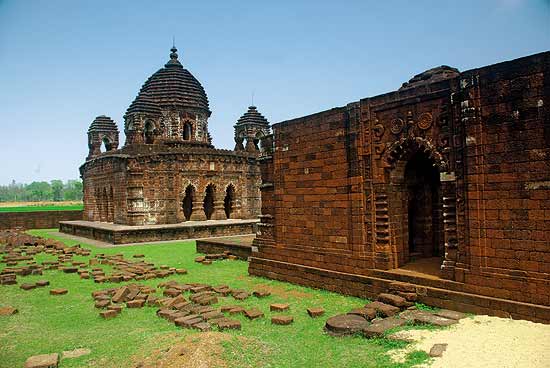
Gokulnagar’s Gokulchand temple in laterite
Kotulpur and Gokulnagar are both within easy distance of Joypur, which has two nine-pinnacled temples with unique terracotta panels at Depara and Dattapara. The sleepy town of Kotulpur is also known for its terracotta temples—the Giri Gobardhan mandir, situated within the premises of the Bhadra family’s residence, and the five-pinnacled Sridhar temple. Gokulnagar’s five-pinnacled Gokulchand temple, however, is made entirely of laterite and girded by a fortified wall.

The Bhadra mansion in Kotulpur

Boats of noblemen in an arch panel at Depara’s Vishnu temple in Joypur

The Laxmi Janardan temple
Back in 1840, Narottam Sinha, the zamindar of Debipur bought some land from the Dewan of Bardhaman to build the Laxmi Janardan mandir. A fine sample of terracotta relief-work—among the best in Bengal—the temple is also known for its sixty-foot-high shikhara in the traditionalrekh-deul style (usually associated with structures in Orissa).

Yashoda and Bal Krishna in relief
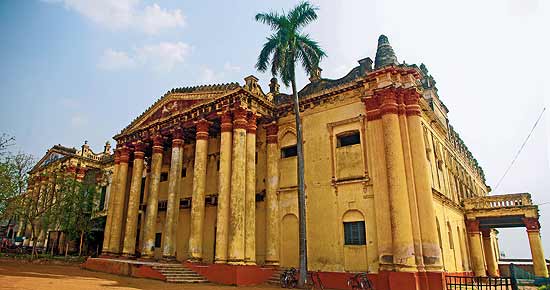
Corinthian pillars at the Hetampur Rajbari
The twin towns of Hetampur and Rajnagar bear markers of both Hindu and Muslim architectural styles. Founded by Raja Bir Singh, Rajnagar was later governed by Pathan rulers; the last Pathan king surrendered to the British after the Battle of Plassey. Hetampur, 20km away, also changed hands and allegiances, from zamindar Raghab Roy to Hatem Khan, and eventually, to the Hetampur Raj family. The latter’s royal palace and two terracotta temples still stand tall here. In Rajnagar, the Motichur mosque, restored by the state government, a ruined imambara and the Rajnagar Palace are the prime drawing cards.
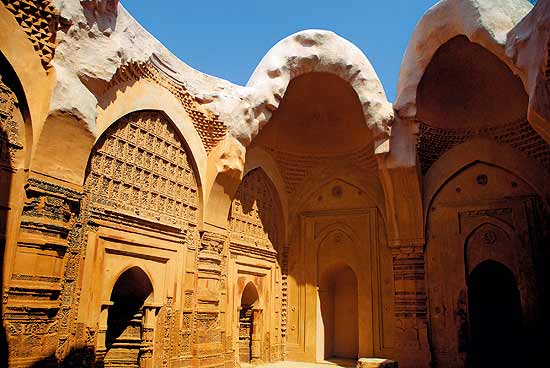
The recently restored seventeenth-century Motichur mosque in Rajnagar
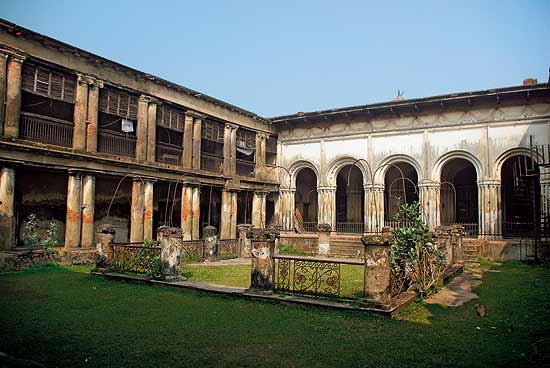
Radha Kunja at Sukharia
Remember Mrinal Sen’s film Akaler Sandhane (1980)? The village featured in the film, with a crumbling zamindar bari (house) and a spectacular terracotta temple with twenty-five shikharas, is none other than Sukharia. Radha Kunja, the Mitra Mustafi family’s ancestral home, has long lost its grandeur, but the Ananda Bhairabi temple has been restored recently. There are several other impressive temples within walking distance of each other in Sukharia. Neighbouring Sripur too is a great repository of Bengal’s built heritage—visit the rasmancha (where idols are placed during the festival of colours or dol), the aatchala (eight-roofed) Shiva temple and thechandimandap (dedicated to the worship of Durga and Shyama Kali) with remarkable woodwork.

Sripur’s rasmancha and chandimandap

Life-sized stucco sculptures at a temple in the village of Ajuria
David McCutchion, an Indophile and scholar who documented and published studies of terracotta temples across east and west Bengal in the 1960s, mentions Daspur as a leading centre of temple building in the nineteenth century. The artisans were known as sutradhara. Even today, several temples, inherited and maintained by a few local families, survive in and around Daspur. Among them are the Pal family’s Laxmi Janardan temple, the Singha family’s Gopinath Ekratna temple and the Goswamis’ Radhagobinda temple in the Dihibaliharpur village nearby. They also each have a namesake in the neighbouring villages of Ajuria, Radhakantapur and Chechua Gobindanagar, respectively.

The Mandal family’s Barataraf residence
The sleepy town of Sonamukhi and the twin villages of Hadal-Narayanpur on the banks of the Bodai river are both two hours away from Bishnupur. Of the several temples in Sonamukhi, the twenty-five-pinnacled Sridhar temple (which is in need of urgent restoration) boasts the best terracotta reliefs. Hadal-Narayanpur, on the other hand, is noted as much for the Mandal family’s terracotta temples—Barataraf, Mejotaraf and Chhototaraf—as it is for their ancestral homes. The Mandal family rose to prominence after gaining favour from the Malla Raja Gopal Singh. The residence of the Baratarafs—the main or senior descendants of the Mandal zamindar family—is no less than a palace. Near the entrance there is a huge rasmancha (an area dedicated to the worship of Radha and Krishna). In an enclosure inside the residence compound there is a bell metal ratha (chariot).
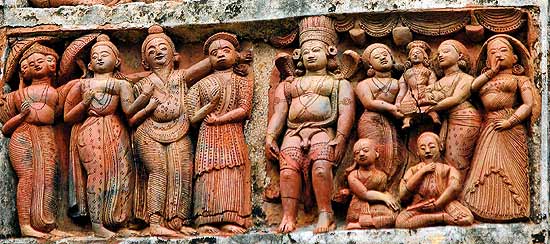
A pageant of Shiva’s wedding at Sonamukhi’s Sridhar temple

Terracotta figurines at the Narajole Palace
The royal family of Narajole was established in 1418 by Zamindar Udaynarayan Ghosh. Their palace, now a part of the Narajole College campus, is a fine specimen of Indo-European architecture. While the façade resembles Parthenon with its Corinthian pillars, its interiors are adorned with terracotta figures. The adjoining navaratna temple, with its basalt sculptures, the twenty-five-pinnacled rasmancha, a series of Shiva temples and a sprawling Hawa Mahal, on the outskirts of the city, are among the other architectural gems in the area.
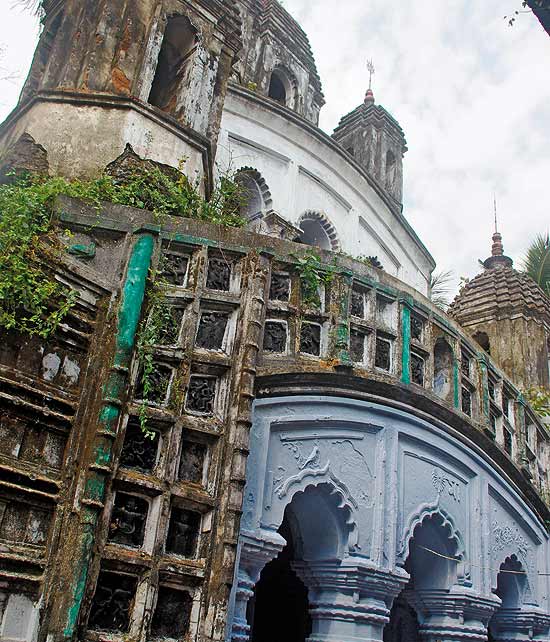
The navaratna temple on the fringes of the town
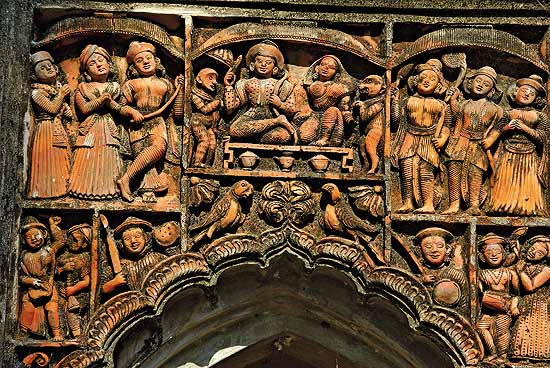
Lord Ram holds court at one of the rekh-deul-style temples in Surul
Although Surul is 5km away from Santiniketan, the hamlet doesn’t quite enjoy the celebrity of its much-feted neighbour. But in the eighteenth century, when one Srinivas Sarkar, a resident of Surul, acquired great wealth by selling sails for ships sailing from the neighbouring port of Ilambazar (which also had a sugar factory), Surul got its own palace and temples. The Rajbari or palace, also the venue for a 250-year-old Durga Puja, is still in good shape. Adjacent to it is the Laxmi Janardan terracotta temple and two Shiva temples in the rekh-deul pattern.
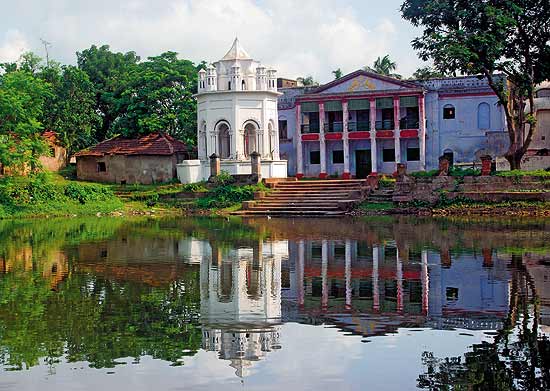
The Palladian Biswas mansion and the octagonal rasmancha
Dasghara is famous for the terracotta panel-studded Gopinath temple constructed by Sadananda Biswas in 1729. But it’s the Biswas family’s Victorian-style mansion with itskachhari (accounts office), baithak khana (an audience room) and an octagonal white-colouredrasmancha on the banks of a huge waterbody, which draws just as much attention. Dasghara’s colonial leanings are also marked by its enormous gate with a clocktower and the mansion of Bipinkrishna Roy, once a stevedore at the neighbouring Calcutta port.

Goddess Saraswati in clay
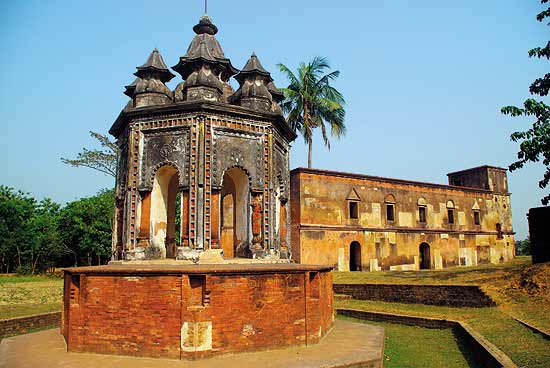
Kuthibari with a small charming nine-pinnacled rasmancha in the foreground
A temple town on the banks of the Kangsabati river, Pathra is best known for its triple-entrancenavaratna temple, the cluster of aatchala (eight-roofed) and pancharatna temples, the deultemple of Sitala and the rasmancha at the Kuthibari mansion. Of these thirty-four nineteenth-century temples, built by the local Majumdar and Bandopadhyay families, currently, twenty-eight are under the supervision of the Archaeological Survey of India, thanks to the efforts of a local gentleman Yeasin Pathan.
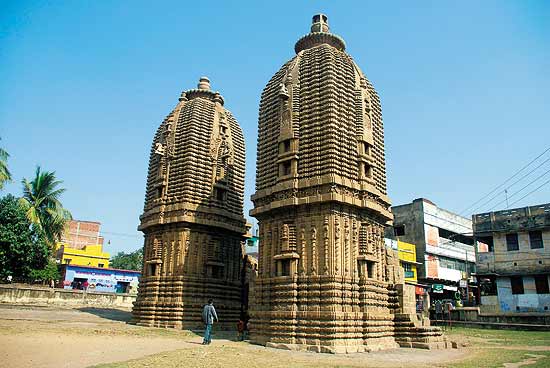
The rekh-deul or shikhara temples
Stone temples, especially in the rekh-deul style of Orissa, are rare in West Bengal. Which is why, the four temples located behind the Begunia market in the industrial town of Barakar, surrounded by coalfields, stand out among the rest. Images of Ganesha and Shiva and many Hindu motifs adorn these temples. The oldest among them is the Siddheshwari temple built between the eight and the ninth centuries. A weekend trip to Barakar can be clubbed with a visit to Maithan Dam (7km) and Kalyaneswari temple (16km).
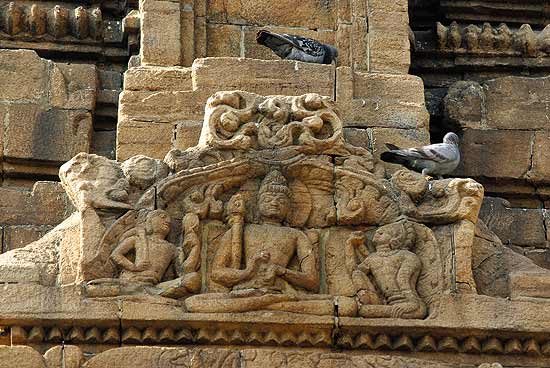
A sculpture on the façade of the Siddheshwari temple
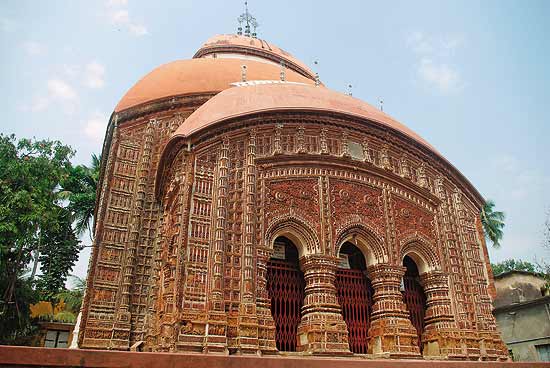
The elaborately decorated Radhagobinda temple in Antpur
Some would recognise Antpur as the place where Swami Vivekananda and eight other disciples of Ramakrishna opted for sanyas in the late nineteenth century. But the Ramakrishna Math is not the only monument in this humble village, near Tarakeswar. Built in 1768, the Radhagobinda terracotta temple, for instance, is a magnificent aatchala (eight-roofed) structure with an adjoining four-roofed porch with three entrances. Antpur also houses five other temples and achandimandap. Rajbalhat, nearby, showcases several terracotta temples as well. A silk-manufacturing hub in the British period, the village still surprises one with scenes of women spinning yarn on wooden charkhas.
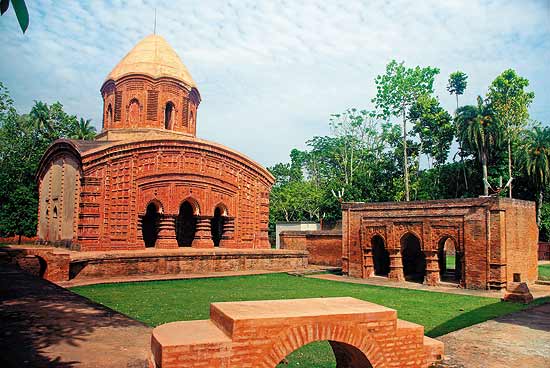
The Ramchandra temple known for its turret and panels of war scenes from the Ramayana
Guptipara is famous for its Ratha Yatra as well as its four terracotta temples which lie within a fortified complex. Of these, the eighteenth-century Ramchandra temple constructed by the king of Sheorafuli, Harishchandra Ray, is adorned with exquisite terracotta panels. It also has an interesting octagonal turret. Brindabanchandra temple, on the other hand, is known for the beautiful frescoes on its inner walls.
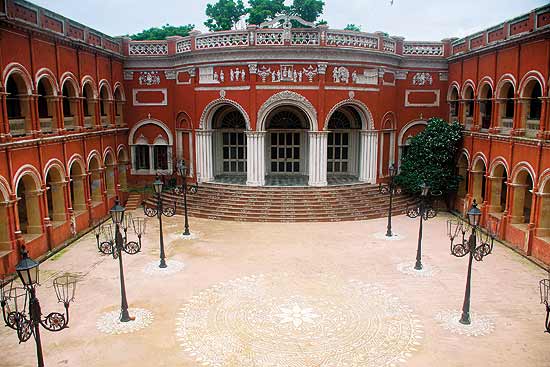
The grand dalan (courtyard) at the Itachuna Rajbari
Taking a cue from Rajasthan, where even minor forts and palaces have been turned into hotels and homestays, the Kundu family at Khanyan (66km from Kolkata) have now opened their doors to tourism. Descendants of the bargees or the Maratha invaders who settled in Bengal, the Kundus have recently converted their sprawling 1766-built Itachuna Rajbari with lavish bedrooms, courtyards and long corridors into a hotel. Promoted as a weekend gateway, they also organise heritage tours to the neighbouring destinations of Debipur, Bandel and Chandannagar.

1 comment:
Awesome blog with beautiful pics! Thanks for sharing the post! Really such a nice and decent information shared here with awesome stuff…
Thanks,
Snigdha G,
Bus Tickets services through TicketGoose.com.
Post a Comment